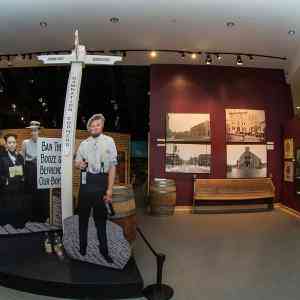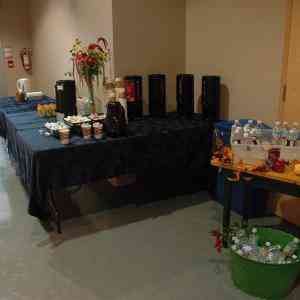Surviving the Unthinkable: Citizen-Soldiers of Grey - Online Exhibit
It has been more than a hundred years since the guns fell silent, with the Treaty of Versailles marking the end of the First World War.
Thousands of young Canadian men and women enlisted for overseas military service in the Canadian Expeditionary Force, determined to "do their bit" for their country and have a grand adventure at the same time. The 31st Grey Regiment, and later the147th and 248th (Grey) Battalions, welcomed hundreds to engage in the fight. Nothing could have prepared them for the nightmare that awaited on the battlefields of Europe.
Most of these soldiers were not fighters; they were nickel platers, students, bookkeepers, and even chicken pickers! In short order, they became sappers, gunners, snipers, and army nurses, and fought to retain their individuality as a professional soldier. The struggle to hold on to their ties back home, to remember themselves as something more than cannon fodder, constantly occupied their thoughts and energies during the pauses between shell blasts.
The men and women of Grey County who served Canada during the Great War were real people, with hopes, dreams and plans for their lives - all of which were put on hold to serve their country and their communities. Many of them never returned to their 'regular' lives, and those who did were forever changed.
Meet some of the brave local men and women who answered the call of King and Country.
- Adams, Laura

- Alexander, Robert Oliver
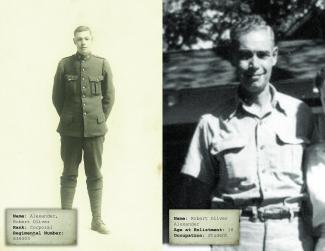
- Alexander, William Arthur
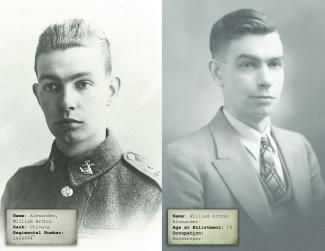
- Bailey, Ernest

- Bell, Alexander Millar
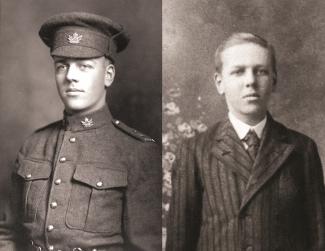
- Bell, John Edwin
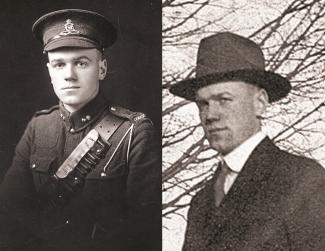
- Bellamy, Mabel Ann
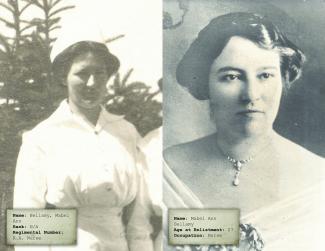
- Camplin, Robert

- Charters, Wilfred

- Cousby, Dorwin Edward
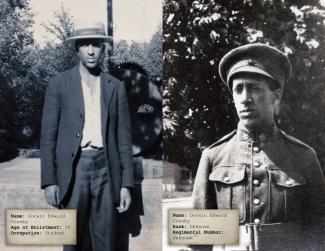
- Cunningham, Fulton Rice

- Fraser, George Cameron

- Fraser, Robert Charles

- French, William Herbert

- Hall, James Henry

- Hemphill, John Argue
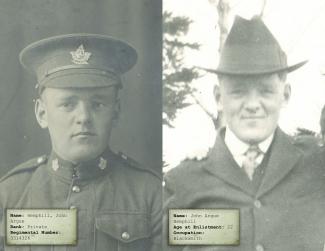
- Hewgill, Clifford William
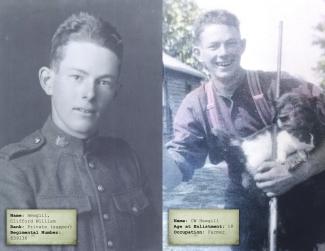
- Iles, William George

- Jamieson, Elwin Newell ‘Jimmie’

- Jucksch, Arnold Homer
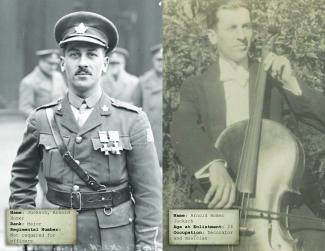
- Kemp, Christian
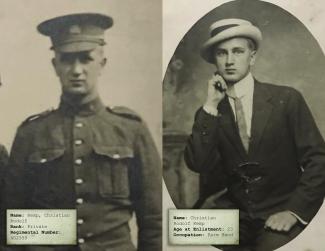
- Kennedy, Edward Miller

- Kennedy, Robert Pollock

- Knisley, William Henry
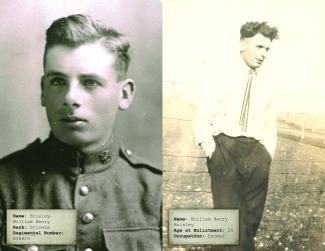
- Kuhl, Christian David

- Laird, Oliver Borden
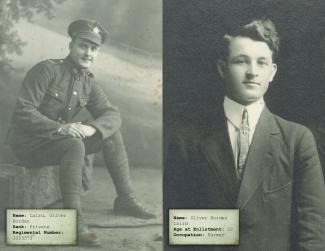
- McClean, Charles Elgin
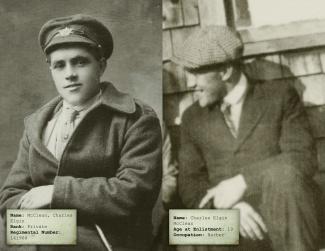
- McConachie, James

- McFaul, Wesley Clarence
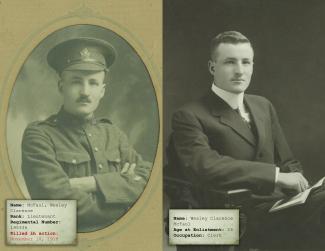
- Morrison, John Lewis

- Neath, Richard
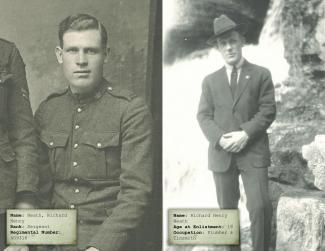
- Nichols, Thomas
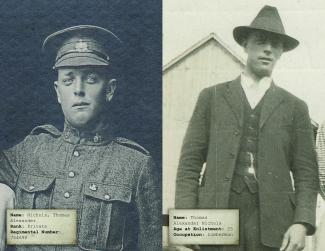
- Ramage, Thomas Alexander

- Sargeant, Jess
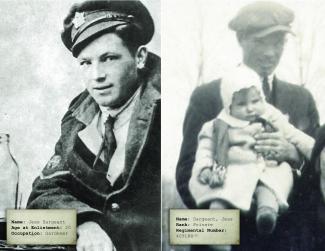
- Torry, Frederick Robert

- Weir, John

- Wilton, Elgin Churchward
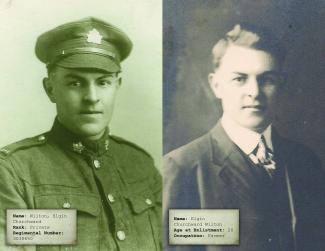

Adams, Laura
April 17, 1884 – May 2, 1941
Enlistment: February 2, 1916 in Chatsworth, ON
Birthplace: Holland Township (Chatsworth)
Units: Canadian Army Medical Corps (Ontario Military Hospital also known as No. 16 Canadian General Hospital – Orpington England, No. 7 Canadian General Hospital – Etaples France)
Wounds: Shell Shock (May 19, 1918)
Date of Demobilisation: October 31, 1919
Laura was stationed at No. 7 Canadian General Hospital near Etaples, France when it was bombed by German aircraft in May 1918. Three nursing sisters in her hospital were killed, as were patients and other medical personnel in the attack, and the hospital was seriously damaged. Laura remained on duty for several days after the initial attack to care for patients, even as the area continued to be subjected to air raids. The trauma of the attack, combined with over a year’s field service in frontline medical care, resulted in what we now call Post-Traumatic Stress Disorder. She was given two months’ convalescence in England to recover then returned to active duty. She returned to Canada in April 1919, remaining active for another six months in the Canadian Army Medical Corps at Brant House, a military hospital in Burlington. Laura’s health declined in the years after the war. She passed away after several months of treatment at Christie Street Veterans’ Hospital and is buried in the veterans’ section of Prospect Cemetery in Toronto. Christie Street Hospital treated veterans with significant, life-altering wounds. Laura never married, but stayed close with her siblings. Her bunkmate in France, May Devitt of Markdale, remained a close friend throughout her life.
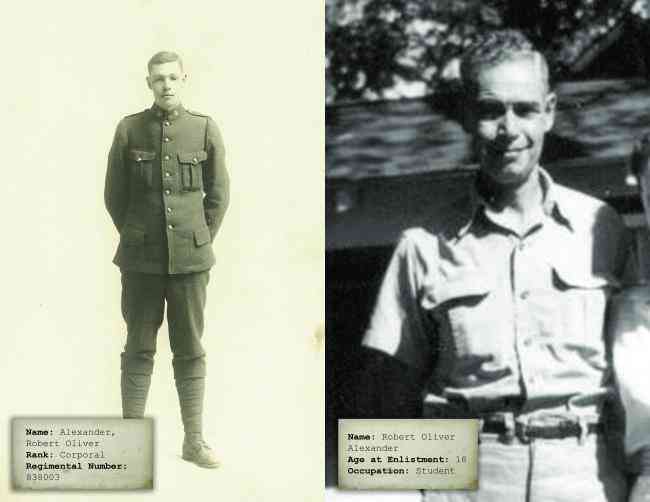
Alexander, Robert Oliver
September 2, 1897 – May 30, 1961
Enlistment: November 27, 1915, Owen Sound
Birthplace: Hoath Head
Units: 147th (Grey) Battalion, 4th Canadian Mounted Rifles, 43rd Canadian Infantry Battalion
Wounds: At Passchendaele (Ypres sector) October 26, 1917.
Date of Demobilisation: March 19, 1919
Oliver enlisted at the end of high school, along with his brother, William Arthur Alexander. Oliver saw action in several active zones in France and Belgium, and was wounded at Passchendaele. Oliver suffered a machine gun bullet wound and fracture of left elbow, which resulted in permanent limited mobility and weakness in the joint. He returned to Owen Sound at the end of the war, married Adda Mae Morrow and settled down in his hometown. Before the war and after, he worked for the Canadian Post Service, eventually rising to become the postmaster of Hanover.

Alexander, William Arthur
September 16, 1899 - March 25, 1979
Enlistment: December 29, 1916, Owen Sound, ON
Birthplace: Thornbury
Units: 248th (Grey) Battalion, 4th Canadian Mounted Rifles
Wounds: Shrapnel wound to left leg, hip and scalp (December 29, 1917), followed by serious infection from wounds received. This left him with “permanent partial loss of function” in his left leg.
Date of Demobilisation: November 7, 1918 due to disability
Bill followed his older brother Robert Oliver into overseas service. At 17, he convinced the recruiting officer that he was 18 and joined the new local unit that was being raised. He was the first soldier from the 248th Battalion to be wounded in combat. After being seriously wounded, Bill spent more than nine months in convalescent hospitals before returning to Canada in September 1918 and finally being discharged just before the Armistice. After returning home, Bill married Ruby Atkins and raised a family. For many years, he served as wharfinger and harbourmaster in Owen Sound and worked as secretary-treasurer of the Owen Sound Transportation Company.

Bailey, Ernest
March 7, 1887 – January 4, 1922
Enlistment: November 16, 1918, Montreal
Birthplace: Birmingham, England
Units: 288 Dys. Royal Engineers, 260th Battalion, 16th Field Ambulance
Wounds: -
Date of Demobilisation: June 18, 1919
Ernest Bayliss came to Canada as a child, one of thousands of children from city orphanages who came to this country. These “Barnardo Home Children” were sent out to find new families, learn farming and grow in a healthy environment. Taken in by Henry and Susan Hemstock, Ernest was raised with their biological children and four other Barnardo Boys. As a young man, he changed his last name to Bailey. He served a year with the Royal Engineers in 1917-1918 then re-enlisted to fight in Siberia. He was assigned to the 16th Field Ambulance and sailed to Vladivostok. The Allies sent troops to Russia to support the government forces against the Bolsheviks. The Allied forces were disorganized and proved no match against the motivated and numerically superior Bolshevik forces. The Canadians served mostly in the volatile port city of Vladivostok, helping to maintain order and keep the city open for government needs. They did not participate directly in any of the fighting. The Canadian effort lasted only six months, and the Canadian Siberian Expeditionary Force returned home by June 1919. Due to health issues, Ernest returned to Canada in April 1919. Ernest and his wife Florence (Wilkie) married in 1915 and had a son James, before Ernest passed away in 1922. Interestingly, in his military photo here, Ernest is clearly wearing corporal’s stripes. According to his military service papers with the Canadian Siberian Expeditionary Force, he was a private. It is possible that he held a higher rank with the Royal Engineers, and had to accept a demotion in order to enlist with the CSEF. About three-quarters of British First World War service papers were destroyed in World War II.
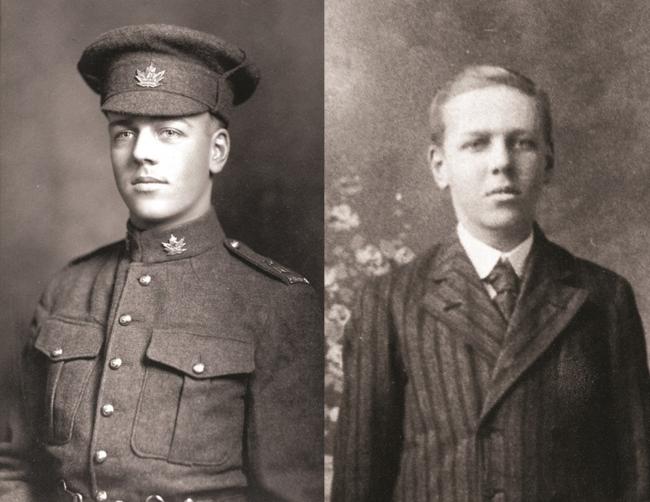
Bell, Alexander Millar
March 7, 1895 – December 18, 1955
Enlistment: August 2, 1915
Birthplace: Glenelg Township
Units: 76th Battalion, 39th Battalion, 49th Battalion, the Alberta Regiment Depot, the 21st Reserve Battalion
Wounds: -
Date of Demobilisation: February 1, 1919
Promotions: Lieutenant (November 23, 1918) Decorations: Military Medal Alec was born and raised in Glenelg Township. As a young man, he worked as a schoolteacher and served in the militia with the 31st Regiment. He enlisted for overseas service in 1915, with his cousins John Weir (also featured in this exhibit), Ernest McGirr and his friend Charlie Ramage, all from the Durham area. He was initially assigned to the 76th Battalion at the training depot at Niagara-On-The-Lake. By the spring of 1916, Alec had arrived in England and had been reassigned to the 39th Battalion. On November 3, 1916, he reported to the 49th Battalion and headed to the front. Within 8 days, he was promoted to lance-corporal, and seven months later, to full corporal. By the time he had been in the field for a year, Mr. Bell the schoolteacher had become Sargent Bell. Alec’s exceptional bravery at the Battle of Amiens was recognized when he was awarded the Military Medal in August 1918. In September 1918, Alec was sent for officer’s training and was promoted to lieutenant in November. After the war, he studied medicine at the University of Toronto and practiced in Durham and Alvinston, Ontario. He married Margaret Huth and together they raised a family. When war broke out again in 1939, Dr. Bell re-enlisted in the Canadian Army Medical Corps, and served on ocean duty, caring for wounded and returning soldiers coming home to Canada. In his later years, he served on Alvinston town council, the public school board, his church. Eventually he became the local Medical Officer of Health.

Bell, John Edwin
August 15, 1898 – February 28, 1958
Enlistment: May 23, 1918, Priceville
Birthplace: Glenelg Township
Units: 67th O.S. Battery Depot, No. 2 Artillery Depot
Wounds: -
Date of Demobilisation: December 23, 1918
After attending Ryerson Normal School, John followed his older brother Alec into the teaching profession, and then into the military. John was attending Knox College at the University of Toronto when he and some friends decided to enlist in the University of Toronto battalion. John reported for duty and trained for several months as a gunner at Camp Petawawa. The war came to an end within just over five months of John’s enlistment, so although trained and ready for duty, he did not go overseas. He went on to study theology at the United Church College in Winnipeg and was ordained by the Manitoba Conference. He faithfully served congregations on Manitoba, Newfoundland and Ontario. He married Mary Mcdonald McIlraith in 1927 and together they raised a family of five. In World War II, John served in the Canadian Chaplain Service, serving in England, Normandy and other part of Europe with the Canadian Army.
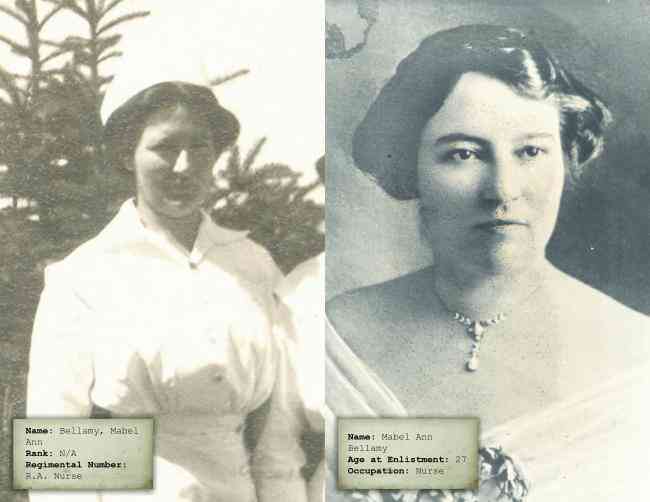
Bellamy, Mabel Ann
June 18, 1891 – April 30, 1971
Enlistment: August 2, 1918, New York City
Birthplace: Mulmur Township, Dufferin County
Units: Base Hospital Camp Meade Maryland, Base Hospital 119, Base Hospital 69
Wounds: -
Date of Demobilisation: July 29, 1919
Although Mabel was born in Dufferin County, she was raised in Osprey Township, near Badjeros in the southeastern part of Grey. Mabel wanted to serve overseas in the Canadian Army Medical Corps, but there were always far more applicants than positions available. Undeterred, she moved to New York City, and enlisted with the American Nursing Corps in August 1918. In the American Expeditionary Force, nurses were not given any rank, and received none of the pay and benefits associated with the officer status that nurses in the Canadian Army earned. After training in the United States, she arrived in France just after the armistice, and served in two base hospitals in the Loire-Atlantique region, near Tours. After she was discharged, she returned to Canada and married William Herbert French, who had served in the Canadian Expeditionary Force. They settled in Keppel Township where they raised two daughters.

Camplin, Robert
February 9, 1895 – December 4, 1980
Enlistment: May 11, 1918 , Heathcote
Birthplace: Quiet Valley, Euphrasia Township
Units: 2nd Central Ontario Regiment, Canadian Machine Gun Depot
Wounds: -
Date of Demobilisation: December 22, 1918 due to illness
A farmer from eastern Grey County, Robert enlisted for service under the Military Service Act. In France, he was posted to the machine gun depot, but after several bouts of ill health, including mumps and bronchitis, he was discharged from service. Returning to Grey County, Robert married Elizabeth (Bessie) Jane Hewgill in 1921 and raised a family. After his wife’s passing in 1937, he worked for the York County Department of Highways and farmed in the Markham area, but remained in touch with his roots in the Beaver Valley.

Charters, Wilfred
February 17, 1895 – November 18, 1958
Enlistment: May 10, 1918, Heathcote
Birthplace: Heathcote
Units: 1st Central Ontario Regiment
Wounds: -
Date of Demobilisation: January 17, 1919
A farmer from Heathcote, Wilfred enlisted for service under the direction of the Military Service Act. Wilfred did not serve overseas, but remained at Exhibition Camp in Toronto, helping to prepare soldiers and supplies for service in Europe. After the war, he married Mary Galbraith and raised two children. His son served in the Royal Canadian Air Force.

Cousby, Dorwin Edward
Date unknown, 1899 - December 30, 1975
Enlistment: Date unknown, Owen Sound, ON
Birthplace: Date unknown, Owen Sound, ON
Units: Unknown
Wounds: Unknown
Date of Demobilisation: Unknown
Over 100 years have passed since the end of the Great War, and over time, some veterans’ service records have disappeared. Little trace remains of Dorwin’s service during World War I but some photographs that testify to his sacrifice. Photographs of him in full uniform reveal that he wore the drab wool 1903 Canadian pattern universal service dress uniform, consisting of a jacket (with modifications dating to 1914), issue trousers and puttees. His khaki waist-belt is of the British 1907 web pattern which was standard issue for Canadian and Commonwealth forces during the First World War. Although difficult to confirm, the badges mounted on his standing collar appear to be Canadian General Service badges worn by soldiers in the Canadian General List. The general list was an administrative arm of the Canadian Army to which soldiers who were not immediately assigned to a unit were posted. It was also responsible for service men performing duties generally not considered within the realm of regular regiments and corps. As an example, units such as those charged with local protective duties within Canada fell within the parameters of the General List category. Dorwin reached service age in 1917, but he suffered an unknown illness early that year which may have prevented him from enlisting or being conscripted. Research continues to fill in details of Dorwin’s experiences. He returned to Owen Sound after the war and worked as a driver and later as a chef on Great Lakes ships. He never married or had children of his own, but remained a valued family member, friend and community member.

Cunningham, Fulton Rice
May 30, 1896 – November 22, 1976
Enlistment: May 11, 1918, Kilsyth
Birthplace: Kilsyth
Units: 2nd Central Ontario Regiment, F Wing Canadian Casualty Centre
Wounds: -
Date of Demobilisation: July 6, 1919
Fulton served under the Military Service Act, reporting for duty just before his 22nd birthday. After three months of training in Canada, he embarked for England and completed more training here. By this time, the war had ended, but Fulton was assigned to F Wing at the Canadian Casualty Centre at Bramshott, where many wounded and ill soldiers awaited transport back to Canada. When Fulton reported for duty, the hospital was preparing the war’s last casualties for transfer home. They were also treating patients from the virulent Spanish influenza pandemic which ultimately killed 779 Canadian soldiers. By June, the medical needs at the hospital had settled, and Fulton boarded a ship to return to Canada.

Fraser, George Cameron
September 12, 1898 - ?
Enlistment: December 19, 1916, Balaclava
Birthplace: Balaclava
Units: 248th (Grey) Battalion, 58th Battalion
Wounds: Gassed (August 28, 1918)
Date of Demobilisation: March 31, 1919
Other than his years in the army in World War I, George spent his entire life on the family farm in Balaclava. A gunner in the artillery, George attacked as part of the Canadian Corps’ offensive in the Last Hundred Days of the war. In the first two weeks of the offensive, the Canadians gained more than 20 kilometres, capturing 9,000 prisoners. George was wounded in a gas attack. After six week’s recovery, he rejoined his unit for the final month of the war. Upon returning home, he married Janet (Jean) Johnstone and they raised their family on the farm that his grandparents pioneered.

Fraser, Robert Charles
May 24, 1872 – June 9, 1949
Enlistment: January 29, 1916, Indian Head, Saskatchewan
Birthplace: Owen Sound
Units: 217th Battalion, 46th Battalion, 4th Battalion (Canadian Machine Gun Corps)
Wounds: Gassed (April 11, 1918)
Date of Demobilisation: July 11, 1919
Robert was born in Owen Sound, but as many young men of his generation did, he went west to homestead at Indian Head, Saskatchewan as a young man. Robert had not been in France long, when he suffered from gas poisoning in an attack. He spent the rest of 1918 at Casualty Clearing Centres in England to recover. After the war, he lived in Owen Sound for a short period, but returned to his farm home in the west. Although he remained a lifelong bachelor, he made a habit of visiting family and friends in the area every few years for the rest of his life.

French, William Herbert
March 15, 1891 – July 11, 1972
Enlistment: November 17, 1914, Owen Sound
Birthplace: Owen Sound
Units: 28th Regiment (Stratford), 31st Battalion
Wounds: Bomb wound (August 7, 1916), gunshot wound (August 10, 1918)
Date of Demobilisation: May 25, 1919
Promotions: Lance-corporal (July 15, 1915), sergeant (March 22, 1917), lieutenant (January 26, 1918) Decorations: Military Cross (March 8, 1919) Before the war, Bill served for six months as a private and a signaller in the 28th Regiment, based in Stratford. During the summer of 1916, he went on a course to learn aircraft signaling, but returned to his unit after three days. He was wounded in his right thigh and left hand at St. Eloi by a bomb in 1916. Bill left an impression with his superior officers, and was selected for Officers’ Training Corps courses in November 1917. He did well, and was rewarded with a promotion to lieutenant in early 1918. He was wounded again, this time in the left arm in Amiens in 1918. After the war, he returned to Owen Sound. He married Mabel Ann Bellamy, a Grey County woman who served as a nurse in the American Army during the war. Together, they raised two daughters in Keppel Township. Bill continued in the militia after the war, and took additional signaling courses. He served as a local recruiting officer during World War II.

Hall, James Henry
January 17, 1895 - ?
Enlistment: December 20, 1915, Massey
Birthplace: Rocky Saugeen
Units: 119th Battalion, 124th Battalion
Wounds: -
Date of Demobilisation: April 12, 1919
James’ family was one of the first pioneer families in Grey County. James moved to Northern Ontario to work in the forests as a sawyer and labourer, and enlisted in a local regiment there. He later transferred to the 124th Battalion (Governor-General’s Body Guard), a unit which trained as infantry but became a pioneer battalion in Europe. Pioneer battalions worked in conjunction with the Engineers, “and continually in the Forward Area: the work in the back area being left to Labour units and Entrenching battalions. The work is varied but consists of consolidating positions captured by the infantry, tunnelling, mining, wiring, railroad work, deep dugout work and laying out, building and keeping trenches in repair.” James endured a series of illnesses related to the conditions in which he worked. After the war, he married Sarah Earlls, his Owen Sound sweetheart. Twenty years later, he enlisted alongside his three sons to serve in World War II.
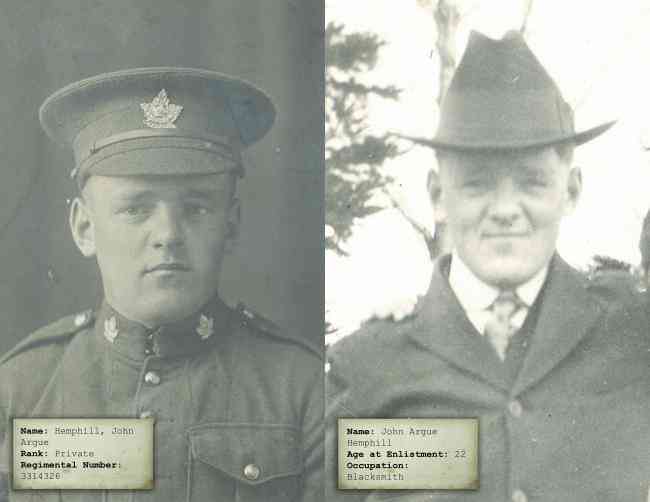
Hemphill, John Argue
September 18, 1895 – July 31, 1923
Enlistment: January 23, 1918, Ceylon
Birthplace: Ceylon
Units: 2nd Central Ontario Regiment, 58th Battalion
Wounds: Shrapnel wound to the back (October 10, 1918)
Date of Demobilisation: April 1, 1919
John served in the Canadian war effort under the Military Services Act. Once in England, he was transferred to the 58th Battalion, and saw action during the Canadian Corps’ Hundred Days offensive which led to the end of the war. A month before the armistice, John suffered shrapnel wounds to his back, a serious injury which left him in hospital for months afterward, and a permanent disability. A blacksmith by trade, the wound affected his livelihood after the war. He drowned in Wilcox Lake near Ceylon, as he went to help a young couple in distress. The bottom suddenly dropped, and unable to swim due in part to his war injury, he went under. He was well known and respected in his community, and his funeral was one of the largest to that time in the Ceylon area.

Hewgill, Clifford William
September 21, 1897 – February 2., 1968
Enlistment: July 31, 1916, Thornbury
Birthplace: Heathcote
Units: 147th (Grey) Battalion, 4th Battalion Canadian Railway Troops
Wounds: -
Date of Demobilisation: April 4, 1919
Clifford William (CW) enlisted as a teenager, and sailed with the 147th on the S.S. Olympic in November 1916. By the time of the Battle of the Somme in mid-1916, it became clear that road and animal transportation alone were not enough to get needed supplies to the front lines. The Canadian Railway Troops filled that gap, and grew from one battalion to a Corps of over 16,000 men. After training with railway units in England for a few weeks, CW landed in France in February 1917. CW was assigned to a Railway Company and constructed and maintained railway lines of all gauges to the front lines. This work ensured that combat troops had the materiel needed to stage modern battles, and wounded men could be evacuated for treatment. Upon returning home, he married Edna Mary Kenny in 1921 and raised two sons in the Blue Mountains area. CW farmed all his life in his hometown.

Iles, William George
February 1, 1885 – April 4, 1964
Enlistment: October 14, 1915, Owen Sound
Birthplace: Cheltenham, England
Units: 76th Battalion, 4th Battalion
Wounds: -
Date of Demobilisation: April 24, 1919
Decorations: Good Conduct Badge (October 14, 1917) Born and raised in England, William married Lily Dudley, and together they emigrated to Canada to begin a new life. They were members of the Salvation Army in England, and remained active in the organization for more than fifty years. William loved music and played for the Salvation Army, as well as the Owen Sound City Band. William enlisted a few months after his younger brother Harold and served as a band member and stretcher bearer. In the early years of the war, British military structure (which Canadians followed) assigned band members to be stretcher-bearers. Band members had no specific combat role, and so were available for other duties during battle. Because they did not engage in combat training, they could receive medical instruction. Their musical abilities indicated that they were intelligent and trainable, and knew how to work together as a unit. This was dangerous work, and by the second half of 1916, the loss of band members while evacuating wounded, led to officers recruiting stretcher-bearers from the infantry. Although William escaped the battlefield with few wounds, his brother Harold was killed on August 8, 1918 at the beginning of the Last Hundred Days offensive. Once back home, he served as bandmaster with the Grey Regiment from 1927 - 1936 as well. Together, William and Lily raised nine children, with five sons serving in the Second World War. William worked at the Empire Stove Company on Owen Sound’s east shore.

Jamieson, Elwin Newell ‘Jimmie’
December 24, 1894 – May 31, 1931
Enlistment: November 20, 1915, Flesherton
Birthplace: Flesherton
Units: 147th (Grey) Battalion, 58th Battalion
Wounds: -
Date of Demobilisation: January 16, 1919
Promotions: Acting sergeant (September 23, 1918) Decorations: Good Conduct Badge (February 2, 1918) Jimmie grew up on a farm at Eugenia, but the construction of the hydro dam and the Eugenia Powerhouse in 1914-1915 created local flooding. The Jamieson farm was covered by the new Lake Eugenia, and the family had to relocate. Jimmie saw his opportunity to support his family, and so enlisted in the new local battalion. Promoted to Lance Corporal in England, Jimmie accepted a demotion back to private in order to get to France with the 58th Battalion. Jimmie fell ill from a virulent strain of trench fever in the fall of 1917, and after recovering in England, remained at the Canadian training camp at Witley (England) until the end of the war. Upon coming home, he married Frances Nicol and together they had four children. Jimmie opened a barbershop on 7th Street East near 2nd Avenue in Owen Sound, but hockey was his passion. He managed the 1924 Owen Sound Greys hockey team, who won the Memorial Cup and was a well-known hockey manager throughout the province. Tragedy struck a few years later, and he passed away in 1931 from pneumonia. Out of respect, Jimmie was accorded a full military funeral. Frances passed away four years later from cancer, leaving their four children to be raised by relatives.

Jucksch, Arnold Homer
December 6, 1890 – August 7, 1954
Enlistment: November 10, 1914 (31st Regiment), February 19, 1916 (147th Battalion for overseas service), Hanover
Birthplace: Hanover
Units: 31st Regiment, 147th (Grey) Battalion, 58th Battalion
Wounds: -
Date of Demobilisation: April 9, 1919
Promotions: Captain (November 10, 1917), Battalion Intelligence Officer (August 10, 1918). Major (October 23, 1918) Decorations: Military Cross (September 9, 1917), Bar to Military Cross (2nd award of this honour, March 26, 1918), Distinguished Service Order (August 27, 1918), Mentioned In Dispatches Homer’s family heritage was German. His father immigrated to Canada as a child, and his mother was born in Neustadt, Ontario to German immigrants. While Homer’s hometown of Hanover was very culturally and linguistically German at the beginning of the First World War, the Jucksch family were active community members and proud Canadians. Homer was a noted singer and musician, and had just been hired as a Great Lakes cruise ship entertainer when the war broke out. Homer and his older brother Reuben enlisted at the beginning of the war. Reuben was quickly accepted for overseas service, but the local 31st Regiment, having filled its quota, only took Homer on as a member of the militia. While waiting to be called up, Homer took an officer’s training course. Homer excelled, and when the 147th (Grey) Battalion was created, he transferred to it as a lieutenant. Once overseas, senior officers recognized the potential in Homer’s many gifts. Fluent in German, Homer’s leadership skills and courage encouraged his superiors to call on Homer to lead trench raids. Over the course of almost eighteen months in France and Belgium, Homer led several successful raids, securing intelligence and prisoners, and sabotaging enemy plans. He was decorated three times for his bravery, and mentioned in dispatches for his courage and leadership. Miraculously, despite the great dangers of trench raiding, Homer was never wounded. Upon his return to Canada, his German name attracted more attention than his exemplary war service, and he suffered prejudice and even hostility because of it. Eventually he and his brothers changed their last name to Jukes to escape this discrimination. Initially after returning to Canada, he took on a position as an administrator at Christie Street Veterans’ Hospital in Toronto, but soon returned to the stage as a singer and vaudevillian. After moving to Los Angeles, a poorly performed tonsillectomy ended his singing career, but he turned his considerable talents to carving and sculpture. He decorated the Hearst Castle and later worked on model aircraft for Lougheed (later Lockheed) Aircraft.

Kemp, Christian
June 30, 1891 – May 9, 1920
Enlistment: January 12, 1915, Desboro
Birthplace: Sullivan Township
Units: 52nd Battalion, 34th Battalion, 9th Battalion
Wounds: Gunshot wound (right arm) (June 5, 1916)
Date of Demobilisation: December 10, 1916
A farmer from Sullivan Township, Christian enlisted early in the war. After arriving overseas, Christian suffered an acute attack of rheumatic fever. Once recovered, he transferred to France. On June 2, 1916 the Germans attacked the Canadian positions at Sanctuary Wood and Hill 62 on the high ground just outside Ypres in Belgium. By June 6, the Germans took their objective and the Canadians were forced to retreat. Although the Canadians eventually retook the position, Christian was wounded by shrapnel in the right forearm in the initial attack. Shortly thereafter, doctors detected a significant heart murmur, and as result of his heart condition, Christian was discharged as “permanently unfit.” The heart condition, a result of the rheumatic fever, left him in poor health for the remainder of his short life. Christian married Merle when he came back to Canada, but they did not enjoy a long life together. Upon his death in 1920, his service papers recorded his passing as “Death due to service.” Christian was one of the war’s soldiers who did not die in battle, but as a direct result of his war experiences.

Kennedy, Edward Miller
September 12, 1892 – April 10, 1916
Enlistment: November 18, 1914, Owen Sound
Birthplace: Owen Sound
Units: 18th Battalion
Wounds: -
Date of Demobilisation: Killed in action (April 10, 1916)
Edward enlisted within the first four months of the outbreak of war. A member of a prominent Owen Sound industrial family, Edward’s brother Paul followed him into service in 1915. After training in Canada and Englnad, Edward joined his unit in the field in France in December 1915. Edward’s unit was part of the 2nd Canadian Division, and in early April 1916, they faced their first major engagement at the Battle of St. Eloi, just outside Ypres. The British had occupied the area previously, and dug tunnels for explosives, in an effort to destroy German defenses. The result instead left the Canadians with a field of muddy, water-filled craters, and few trenches in which to take cover. During two weeks of battle, the mud interfered with communication and made fighting difficult. This, combined with the aggressive German counter-attack left the Canadians with little accurate information as to the process of the battle. By April 16, the Germans held most of the key points in the sector and the Canadians retreated. Over the course of thirteen days of fighting, the Canadians suffered 1,373 casualties. Edward was reported as killed in action by his commanding Officer on April 10 in an attack north of Courcelette. His body was never found amidst the mud and water St. Eloi. He is honoured at the Menin Gate Memorial is situated at the eastern side of the town of Ypres (now leper). It bears the names of 55,000 men who were lost without trace during the defense of the Ypres Salient in the First World War. Over the two staircases leading from the main Hall is the inscription: HERE ARE RECOREDED NAMES OF OFFICERS AND MEN WHO FELL IN YPRES SALIENT BUT TO WHOM THE FORTUNE OF WAR DENIED THE KNOWN AND HONOURED BURIAL GIVEN TO THEIR COMRADES IN DEATH.

Kennedy, Robert Pollock
October 7, 1895 – April 12, 1973
Enlistment: August 31, 1915, Owen Sound
Birthplace: Owen Sound
Units: 31st Regiment, Fort Garry Horse Regiment
Wounds: No. 2 Canadian General Hospital Le Treport (August 27, 1916) as a result of being thrown from a horse
Date of Demobilisation: March 27, 1919
A member of prominent Owen Sound industrial family, Robert Pollock (Paul) followed his older brother Edward and enlisted early in the war. Paul was attached to the Fort Garry Horse. After serving a year in France, he was thrown from his horse during the Somme Offensive and spent several weeks recuperating from his injuries. Much of the 1917 and 1918 were spent in hospital with illnesses, but by August 1918, he was back in the field. On August 8, 1918, his horse was hit and killed by shell as Paul was riding him. Thereafter, Paul himself developed a heart condition which took him out of the line, although he continued to serve at the front for another month. Returning home, he married Rhoda Jean Ross In 1928. In the 1940s, he moved to Guelph and owned the Guelph Paper Co., before returning to Owen Sound to take over foundry sales for the family business.
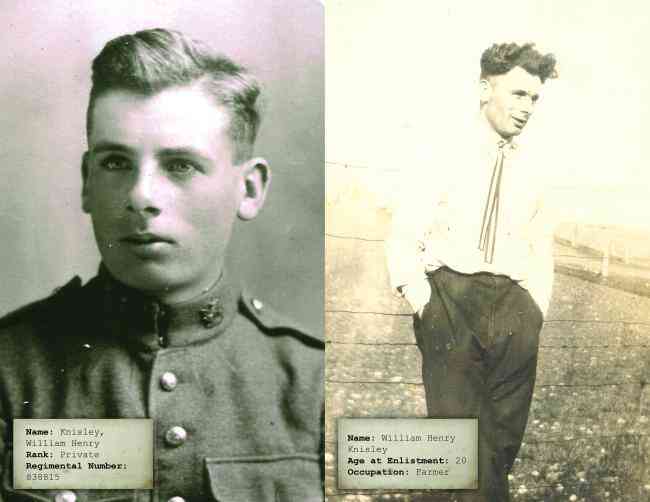
Knisley, William Henry
August 8, 1897 – ?
Enlistment: February 14, 1916, Durham
Birthplace: Arthur, Wellington County
Units: 147th (Grey) Battalion, 4th Canadian Mounted Rifles
Wounds: -
Date of Demobilisation: January 16, 1919
Promotions: Acting Lance Corporal (October 7, 1918) Decorations: Good Conduct Badge (February 14, 1918) William joined the 147th in the winter of 1916. It took nearly a year for him to arrive in England. By April 1917, many men from the 147th were transferred to the 4th Canadian Mounted Rifles, including Oliver and Bill Alexander, and future Victoria Cross recipient Tommy Holmes. In mid-October 1917, William reported sick with appendicitis and was identified as a diphtheria carrier. He came down with a mild case of it himself and spent the next three months in hospital. This meant that he missed the Battle of Passchendaele, during which Tommy Holmes won the Victoria Cross and Oliver Alexander was wounded. By February 1918, he was discharged from hospital, and sent to the 3rd Canadian Reserve Battalion in Wittley. He was promoted and sent for further training, but did not return to France before the end of the war.
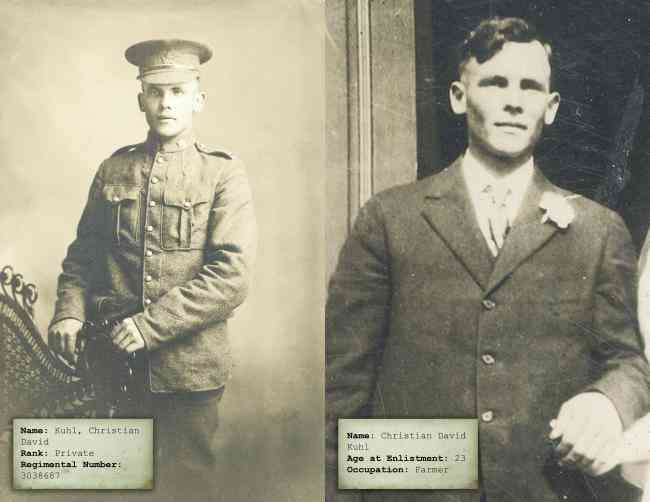
Kuhl, Christian David
March 5, 1895 – August 10, 1978
Enlistment: May 18, 1918, Marmion, ON
Birthplace: Sullivan Township
Units: 1st Battalion 1st Central Ontario Regiment, 3rd Reserve Battalion
Wounds: -
Date of Demobilisation: August 23, 1919
Christian was a Grey County farmer who served under the auspices of the Military Service Act. Christian arrived in England by August 1918, but was immediately taken ill. After a month in hospital, he began training for duty, when he was struck by the Spanish Flu and became gravely ill, spending the next four months in hospital. His poor luck continued, and after two short months of good health, an infection in his right foot and leg took him back to hospital until his discharge in August. Upon returning home, he took over the family farm in Sullivan and in 1921 married Emma Maluske, with whom he had seven sons.

Laird, Oliver Borden
November 1, 1895 – September 24, 1993
Enlistment: June 25, 1918, Rosetown, Saskatchewan
Birthplace: Owen Sound
Units: 1st Depot Battalion Saskatchewan Regiment, Canadian Army Dental Corps
Wounds: Fractured wrist (November 29, 1918)
Date of Demobilisation: May 10, 1919
At 14 years old, O.B. accompanied a carload of horses to Saskatchewan, marking his first adventure. During the First World War, he farmed and attended the University of Saskatoon, until the Military Service Act called him into service. After receiving basic training, O.B. was sent to Siberia in October 1918 with the Canadian Siberian Expeditionary Force (CSEF). While attached to the Base Headquarters in Vladivostock, he broke his wrist playing a friendly game of football. His education singled him out for a special role in Russia. In May 1915, the Canadian Army Dental Corps formed, and it had a unit serving as part of the CSEF. O.B. served as a dental assistant in a German prisoner of war camp. By the spring of 1919, the CSEF was called back to Canada, and O.B. returned home. Returning to civilian life, he started a fox farm with his brother in Saskatchewan, and later married and raised a family of his own.
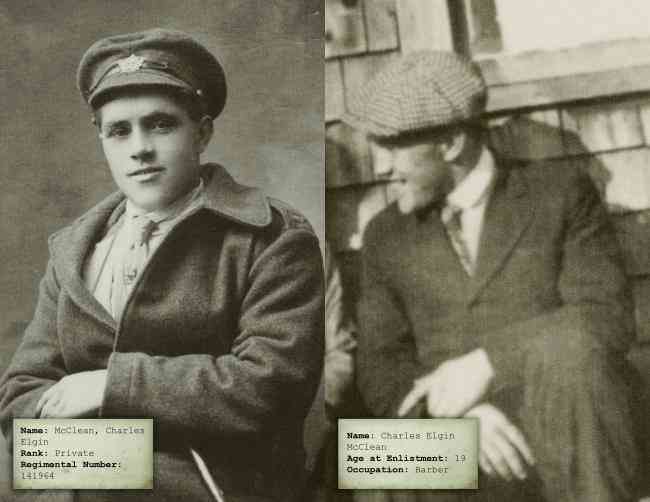
McClean, Charles Elgin
October 27, 1896 – January 12, 1969
Enlistment: August 2, 1915, Flesherton
Birthplace: Massie
Units: 76th Battalion, 1st Canadian Entrenching Battalion, 4th Battalion
Wounds: Bayonet wound left hand (October 8, 1916), shrapnel wound right leg resulting in compound fracture (August 16, 1917)
Date of Demobilisation: March 13, 1919 due to wounds received
Charles was working on the building of the dam at Eugenia prior to enlisting. His unit embarked for overseas from Halifax in April of 1916 aboard SS Empress. On August 15, 1917 the Canadians attacked Hill 70 at Lens to distract the Germans from other Allied movements in Passchendaele. On the second day of fighting, Charlie was hit with a severe shrapnel wound to the right leg and sent back to England where he spent the rest of the war in and out of different hospitals due to the injury to his leg. At one of them he met his future wife, Daisy Miles, who was a volunteer. They got married on June 15, 1918 in London, England. Charlie returned to Canada with his new bride on S.S. Metagama which sailed out of Liverpool on Feb. 8, 1919. They resided in Markdale for a few years prior to getting a farm near Vandaleur. As many did, they lost the farm during the depression and later lived in Flesherton for a few years before moving to Brampton. They had three sons and a daughter. All three sons served during WWII.

McConachie, James
March 27, 1895 - September 17, 1961
Enlistment: March 13, 1916, Palmerston
Birthplace: Palmerston
Units: 153rd Battalion, 122nd Battalion, 49th Company of the Canadian Forestry Corps
Wounds: -
Date of Demobilisation: April 2, 1919
Promotions: Lance-Corporal (October 26, 1916) James was born in Palmerston but grew up in Owen Sound. A chair maker by trade, James was working in Palmerston when he enlisted, two weeks before his 21st birthday. At some time before his enlistment, James was involved in an accident with a circular saw, and lost the top portion of his index and second finger on his right hand. This rendered him unfit for service in the infantry, but as a strong and healthy young man, there were many other ways that he could serve his country. Shortly after enlisting, he fell ill with peritonitis, a severe abdominal infection, and spent the rest of 1916 recovering in hospital in St. Thomas. By May 1917, he headed for Europe and by July, was assigned to the 49th Company of the Canadian Forestry Corps in France. He served as company cook upon arrival, a position which merited him a pay rate of $1.75 per day, a significant increase over the general enlisted soldier’s pay of $1.10 a day. The Forestry Corps provided lumber for the war effort, both in the United Kingdom and in Europe. They also cleared terrain and prepared railway ties and other necessary wood products. When James was discharged in the spring of 1919, he returned to Owen Sound. He married Stella Barrett in June of that year, and together they raised three children in the city. He worked for many years at Kennedy’s, designing ship propellers.

McFaul, Wesley Clarence
March 27, 1891 – November 10, 1918
Enlistment: November 25, 1915, Owen Sound
Birthplace: Owen Sound
Units: 31st Regiment, 57th Regiment, 93rd Battalion, 19th Battalion
Wounds: Gunshot wound (August 18, 1918)
Date of Demobilisation: Killed in action November 10, 1918
Promotions: Acting lance corporal (May 20, 1917), Lieutenant (April 28, 1918) Clarence worked as a clerk in his family’s grocery store, McFaul’s Limited, in downtown Owen Sound. A bright young man, upon enlisting he was trained as a signaler. Clarence arrived overseas in July 1916. In February 1918 he was sent to cadet corps in England for officers’ training. By mid-June 1918, he returned to the 19th Battalion as an officer. As field officers, lieutenants had one of the highest casualties rates in the infantry. Clarence was no exception, and was shot in the right forearm in the early days of the Last Hundred Days Offensive. After several weeks’ recovery, he rejoined his unit at the end of October, twelve days before he was killed. The official report noted that "(h)e was standing in the garden of a house in Hyon about 2:30 p.m. on November 10th, 1918, when a shell exploded at his feet, wounding him in the leg and right shoulder. He was rendered unconscious and died about five minutes after being hit." His two brothers, Private Cecil McFaul with the 1st Canadian Tank Battalion and Lieutenant Lawrence McFaul with the Royal Canadian Engineers survived the war. Although Clarence is buried in Mons, Belgium, his father erected a grave marker in the family plot at Greenwood Cemetery in Owen Sound.
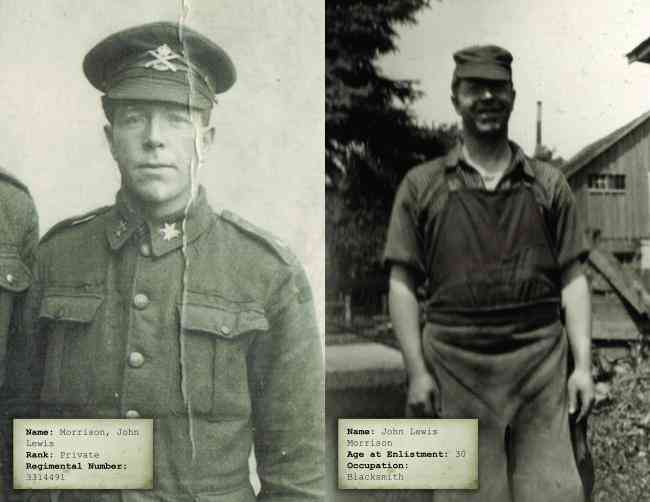
Morrison, John Lewis
September 26, 1887 – August 27, 1971
Enlistment: January 23, 1918, Flesherton
Birthplace: Osprey Township
Units: 31st Regiment, 2nd Central Ontario Regiment, 4th Battalion Canadian Machine Gun Corps.
Wounds: -
Date of Demobilisation: June 16, 1919
John had previously served for one month in the 31st Regiment, but his active war service came under the Military Service Act when he reported for duty in January 1918. By August 1918, he had arrived in France for The Last Hundred Days Canadian offensive as a machine gunner. After a month in the field, John fell ill with trench fever and spent almost a month in hospital. He returned to his unit nine days before the armistice was declared. Upon his return to Canada, he continued blacksmithing in Maxwell and McIntyre Corners, and worked at the shipyards in Collingwood. He married and raised a family.

Neath, Richard
May 18, 1897 – September 19, 1985
Enlistment: September 11, 1915, Owen Sound
Birthplace: Glatton, Huntingtonshire, England
Units: 31st Regiment, 76th Battalion, 37th Battalion, 18th Battalion (4th Canadian Trench Mortar Battery)
Wounds: Gassed (August 29, 1918)
Date of Demobilisation: May 24, 1919
Promotions: Lance-corporal (December 12, 1915), Corporal (July 7, 1916), Sergeant (December 23, 1918) Like many who enlisted in the early years of the war, Dick was born in England, although his family immigrated to Canada when he was a child. In fact, before the war’s end, his four brothers had joined him overseas in military service. Dick was a tradesman with some military experience before the war. He had been active in the militia, serving for a year with the 31st Regiment. However, in the early years of the war, the 31st Regiment easily filled its overseas quota, and so Dick transferred to the 76th Battalion in order to get to Europe. In recognition of his military experience, he was quickly promoted from private to lance-corporal. In July 1916, he was promoted to full corporal, to complete the establishment of the 4th Canadian Trench Mortar Battery. In August 1918, he was gassed and spent almost two months recovering. By mid-October he rejoined his unit for the final weeks of the fighting. Sadly, his father passed away while he was in France. Dick and all of his brothers returned from the war. Upon his return, Dick married Myrtle Fleming and raised a family in Owen Sound.

Nichols, Thomas
October 25, 1891 – May 11, 1970
Enlistment: February 9, 1916, Thessalon, ON
Birthplace: Keppel Township
Units: 119th Battalion, 124th Battalion, 4th Canadian Engineering Battalion, 2nd Tramway Company
Wounds: Shrapnel left knee (June 16, 1918)
Date of Demobilisation: March 29, 1919
Tom was born in Grey County, but as a “lumberman” before the war, had moved to northern Ontario for work. After a bout of illness upon arriving in England, he was sent to France in 1917. By June, he was attached to a special engineering unit, which became the 2nd Tramway Company. A tramway unit was responsible for laying and running 60 centimeter gauge tramlines on leveled ground. This in itself was dangerous task as the lines often were in range of the guns and traversed ground totally obliterated by the fighting. The rails (in two pairs, one for up traffic and a second for down traffic) did not sink into the mud like the wheels of motor transport or wagons because of sleepers beneath the rails that act like the toes of a foot, distributing the load over a considerable area of the surface. A comparatively small tramway truck could easily carry as much as any large wagon. An engineer officer noted in September 1916, the infantry would extract much joy and pleasure from sitting on top of the trolleys and wagons that would on their homeward run rattle downhill at amazing speed from High Wood, the men shouting and yelling like school kids. It was also noted by the same officer that this past time was most dangerous, and legs were broken. In June 1918, a shell exploded near Tom, and shrapnel entered his knee. He spent only two weeks in the hospital recovering from this injury, before he was discharged for duty. He walked with a limp for the rest of his life as a result. Tom returned home after the war, and married Margaret Draper in 1920. In 1936, they moved to Hearst, where Tom worked in bush camps until moving to Cochrane in the early 1950s, where he spent the remainder of his days.
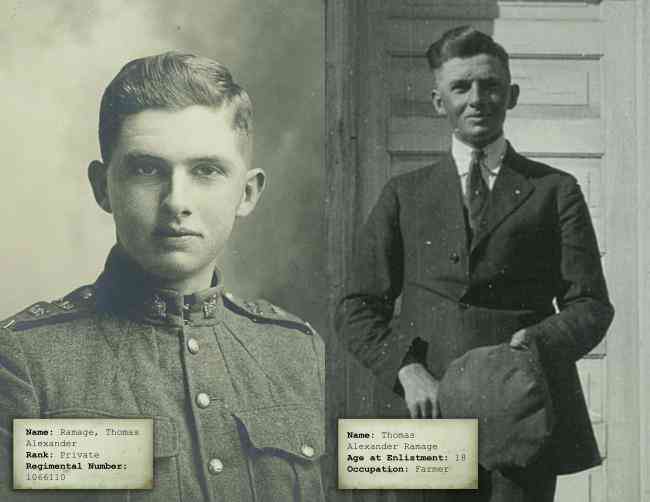
Ramage, Thomas Alexander
June 22, 1898 - 1968
Enlistment: February 21, 1917, Chatsworth
Birthplace: Strathaven
Units: 248th (Grey) Battalion, 4th Canadian Mounted Rifles
Wounds: -
Date of Demobilisation: March 19, 1919
Thomas joined the Canadian Expeditionary Force as soon as he could. Before the end of 1917, he was assigned to the 4th Canadian Mounted Rifles, a unit with many other local soldiers. His natural abilities impressed his commanding officer, so that even sixteen years after the war, his superior wrote a glowing letter of recommendation. During the last month of the war, he was sent on a specialized training course, and returned from his studies at the end of November 1918. After the war, Thomas married Jennie Fraser in 1924, and they raised three children together. Thomas farmed in Sydenham Township for many years, and became active in municipal politics, serving a reeve of Sydenham in 1934. In 1936 he became governor of the Owen Sound jail, which he faithfully served until his retirement in 1965. A harness horse racing enthusiast, he was official starter at the weekly races in Owen Sound and Hanover, continuing to officiate until the week before his passing.

Sargeant, Jess
October 14, 1894 – February 7, 1939
Enlistment: June 11, 1915, Owen Sound
Birthplace: Derby Township
Units: 31st (Grey) Regiment, 37th Battalion, 21st Battalion
Wounds: Passchendaele (November 4, 1917), Avesnes-le-sec (northeast of Cambrai) (October 11, 1918)
Date of Demobilisation: March 15, 1919
Promotions: Lance-Corporal (May 9, 1917), Corporal (August 26, 1918) Decorations: mentioned in the 21st Battalion’s official war diary for special commendation in the Attack on Hill 70 (August 14 – 15, 1917) Jess worked as a gardener for a fruit and vegetable producer near Owen Sound’s Greenwood Cemetery before the war. A sensitive, caring young man, Jess enlisted early in the war. He married his sweetheart Nora Mothersell before heading overseas. The war took a toll on him, as he saw action at Hill 70, Passchendaele and Cambrai, amongst other battles. He was wounded in the neck at Passchendaele, requiring months of recovery due to a subsequent infection. He received a gunshot wound to the palm of his left hand in the final month of the war, which left him with a slight but permanent disability. Although his physical wounds healed and he returned home to a loving family, the war had irrevocably changed this thoughtful young man. He was plagued by debilitating headaches and violent outbursts. He spent hours in silence, staring blankly, unblinking, at nothing. He tried homesteading in Saskatchewan in the early 1920s but returned to Ontario. Although he and Nora had eight children, his health continued to suffer, and he spent long periods at the Westminster Hospital (for veterans) in London before passing away at 44 from acute pulmonary edema.

Torry, Frederick Robert
May 16, 1893 - 1965
Enlistment: January 6, 1916, Durham
Birthplace: Durham
Units: 147th (Grey) Battalion, 4th Canadian Mounted Rifles, 3rd Engineering Battalion
Wounds: -
Date of Demobilisation: March 20, 1919
Fred’s experience as a machinist was useful for the military. Shortly after he landed in France in March 1917, he was assigned to an engineering unit. Immediately after the attack on Vimy Ridge, he was returned to the 4th Canadian Mounted Rifles. While on duty, he occasionally snuck packages of souvenirs home to his sisters. He served with the 4th CMR throughout the balance of 1917 and 1918 until the armistice. Fred managed to escape every battle and engagement where his outfit, including Passchendaele, where so many of his mates were killed or wounded without injury, and returned home in 1919 without any illness or wound. Soon after his return home, he married Hazel Dennett and had a son. They moved to Toronto and in 1922 he began a 41 year career with the Toronto Transit Commission.
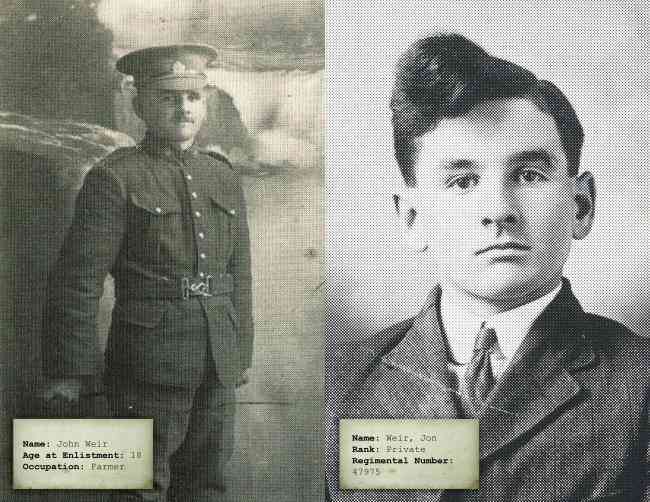
Weir, John
July 28, 1896 – September 26, 1916
Enlistment: May 27, 1915, Glenelg Township
Birthplace: Glenelg Township
Units: 37th Battalion, 17th Battalion, 15th Battalion of the 48th Highlanders of Canada
Wounds: -
Date of Demobilisation: Killed in action September 26 1916
One of John’s earliest reports from military life came in July 1915 when he was disciplined at the Canadian Base at Shorncliffe England for having his lights on after 9:30. While air raids were fairly primitive during the First World War compared to World War II, and sleep did not come easy for a 19 year old on his first adventure away from the family farm, it was imperative to keep military posts secret from the enemy, and to instill discipline before arriving in the trenches. John was confined to barracks for 5 days as a result pf his transgression. Three days after his punishment ended, he was transferred to France as part of the 15th Battalion of the 48th Highlanders of Canada. In June 1916, he was granted seven days leave. By September, the 15th Battalion was in the thick of the fighting during the Battle of the Somme offensive. John and his unit moved into position on the evening of September 24 just outside the village of Courcelette, recently captured by the Canadians. After pounding the enemy with one hundred thousand shells, including gas, the 15th Battalion ready itself for the assault. Just after 12:30 pm on September 26th, they crept from their trench and by mid-afternoon they had captured their first objective. The cost was very high, producing the second highest casualty list of the war. Twenty-year-old John Weir and 116 others paid the ultimate price. John’s body was never recovered. His name is inscribed on the Vimy Memorial in 1936, along with 11,284 other Canadians with no known grave.

Wilton, Elgin Churchward
July 28, 1897 – April 24, 1952
Enlistment: May 18, 1918, Durham
Birthplace: Proton Township
Units: 1st Central Ontario Regiment, 2nd Canadian Mounted Rifles
Wounds: -
Date of Demobilisation: March 28, 1919
A young farmer, Elgin served later in the war effort under the Military Services Act. He left Canada in mid-July 1918, and after training and orientation in England, he arrived in France to serve with the 2nd Canadian Mounted Rifles on October 21, 1918. Within a week of his arrival, Elgin came down with bronchitis and laryngitis, landing him in hospital for three weeks. By the time he recovered, the war had ended. When Elgin returned to Canada, he married Anna Neilena Marshall and they raised a family together in rural Grey County.







